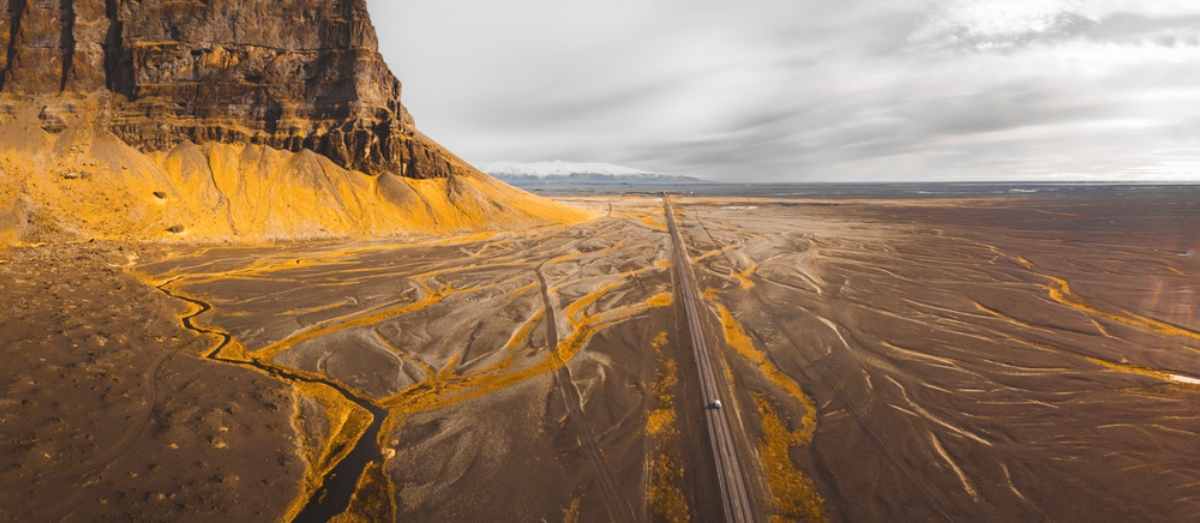The full loop covers 1,322 kilometers (821 miles) and takes about 17 hours of non-stop driving under ideal conditions. However, to truly soak in Iceland’s beauty, we recommend a trip of at least 7–10 days to allow time for sightseeing and stops at must-see stops.
Estimated Driving Times
| Route & Conditions | Estimated Time |
|---|---|
| Non-stop drive (ideal conditions) | 17 hours |
| Recommended trip duration (with stops) | 7–10 days |
| Summer travel (long daylight hours, good roads) | 7–10 days |
| Winter travel (short daylight, icy roads, slower pace) | 10–14 days |
Driving around Iceland along the Ring Road (Route 1) is one of the best ways to truly explore the country's breathtaking landscapes—rushing through just wouldn’t do it justice. If you're planning on renting a car in Iceland and want to experience the island properly, let’s dive into what driving in Iceland really entails. Buckle up—we're about to hit the road!
Iceland's Ring road: Distance & Travel Times
The best way to drive around Iceland is definitely through the Ring Road, and it's easy to explain why. Firstly, as the name suggests, the Ring Road is a circular loop road that runs the circumference of Iceland. This means that it will give you a taste of all the different landscapes and terrains the Land of Fire and Ice has to show off to visitors.
Secondly, many of Iceland’s main attractions and activities can be found along this route. That makes it pretty convenient for any road trip itinerary. Many shorter road trip routes such as the South Coast Way are merely a specific section of the larger Ring Road route. But how long is the Icelandic Ring Road exactly? Well, it is 1322 kilometers. But it’s not really the Ring Road’s length that will dictate the length of your road trip in Iceland.
The Ring Road distance is merely to use as a guideline. You will need to dive into everything this route has going on in order to properly plan out your itinerary and upcoming trip. Luckily, we’ve already included an itinerary in this article, so we’ve already done half the work for you. And if you are you a fact lover... Well, we got those juicy details about Iceland's size and distances!

Ring Road Fast Facts:
- Total Ring Road Distance: 1,322 km (821 miles)
- Average Daily Driving Distance (7-day trip): About 190 km (118 miles) per day
- Recommended Transport: Rent a car or campervan—best way to keep things flexible!
- Highland Roads (F-roads) Requirement: 4x4 vehicle required by law
Iceland’s Size & Distances:
Did you know Iceland is bigger than it seems? Here’s a quick snapshot:
- Total land area: 103,000 km² (39,769 mi²)
- Coastline length: ~4,970 km (3,088 miles)
- North to South distance: around 300 km (186 miles)
- East to West distance: roughly 500 km (311 miles)
Best Time to Drive Around Iceland
Iceland is a land of breathtaking extremes, where each season offers its own set of opportunities and challenges for the avid road tripper. The weather in Iceland varies greatly depending on the season, so let's dig a bit more:
Summer
In the summer (June–August), you'll enjoy extended daylight—over 20 hours in some cases—and mild weather, making it the perfect time to hit every corner of the island. However, the downside is that summer in Iceland also attracts more tourists, and rental costs tend to be higher.
- Pros: Long daylight hours (20+ hours) with the midnight sun, mild weather, all roads open
- Cons: More tourists, higher rental costs
- Recommended Trip Duration: 7–10 days
Fall
Come autumn (September–October), Iceland transforms into a canvas of stunning fall colors, and the crowds begin to thin out, offering a more relaxed travel experience. It’s also the time when you might catch the Northern Lights, though the weather can be unpredictable and some F-roads start to close as winter looms.
- Pros: Fewer tourists, stunning fall colors, Northern Lights visible
- Cons: Unpredictable weather, some F-roads start closing
- Recommended Trip Duration: 7–10 days

Winter
During Iceland in the winter (November–March), the island becomes a snowy wonderland. The dramatic scenes of snow and ice, along with the chance to see the Northern Lights, are truly magical. However, winter driving comes with challenges: daylight hours can be as short as four in December, roads may be icy, driving in snow and closures are common.
- Pros: Northern Lights, snowy landscapes, unique winter experiences
- Cons: Short daylight hours (as little as 4 hours in December), icy roads, road closures
- Recommended Trip Duration: 10–14 days
Spring
Finally, spring (April–May) brings a burst of color as the land blooms, and the daylight slowly increases. Fewer tourists mean you can explore more peacefully, but be aware that some F-roads may still be closed due to lingering winter conditions.
- Pros: Blooming landscapes, fewer tourists, increasing daylight
- Cons: Some F-roads still closed, unpredictable weather
- Recommended Trip Duration: 7–10 days
No matter which season you choose for your Icelandic adventure, careful planning and the right vehicle can make all the difference. Enjoy your journey!

Driving Conditions & Road Rules in Iceland
Here in Iceland, it’s not just the weather conditions that can throw a spanner in the works of a road trip - it’s also the Iceland roads themselves.
The island has many different roads and routes running all around the island. And while the majority of the main routes are all paved and well-maintained, there are a few gravel roads here and there. Then there are the rough-and-tough F-roads in Iceland that can legally only be accessed with a 4x4 vehicle.
Driving on a main road in Iceland will be fairly similar to driving on a main road in your home country (but probably with less traffic). It’s safe and you can just cruise along. But once you hit those gravel roads or F-roads, it’s another story altogether. These roads require focus and can take half an hour just to drive 1 kilometer.
These types of time constraints are very important to keep in mind when planning your itinerary. And you should have a chat with your rental agency regarding your route around Iceland. This way, they can properly advise you on which type of vehicle you’ll need and the rental insurance you need to get.

Route 1 speed Limits and Driving Hazards
As we already mentioned, the Ring Road is one of Iceland’s main routes. In fact, even though it may not resemble what you’re used to, the Ring Road connects major cities and towns and is considered the island's highway.
Icelanders take road rules seriously, and breaking them can result in hefty fines. That’s why it’s so important that you know what these rules are and stick to them.
Keeping to the speed limit is probably one of the most important rules of the road, and is very different from most speed limits across the world. Speed limits in Iceland vary from 30-50 km/h in populated areas, 80 km/h on gravel roads, and 90 km/h on paved roads.

Since the Ring Road is the latter, your speed limit during your road trip will mostly be 90 kilometers. But keep an eye out for the Iceland road signs next to the road telling you what the speed limits are. Telling an officer “but I didn’t know” is not going to fly as an excuse here. The Ring Road has speed limits lower than 120 km/h. It highly affects how much distance you can cover in a day and should be considered when planning your itinerary.
Watch out for hazards like road closures due to weather circumstances and wildlife crossings. Or seasonal road closures in colder months (especially in the Highlands and Westfjords).
Now that you know all about Iceland's Ring Road and driving in Iceland, it's time to get inspired for that once in a lifetime road trip. Here are some itinerary ideas for the perfect road trip!
7-day Ring Road Itinerary
Here’s a 7-day Ring Road itinerary for your Iceland self-drive tour. Use it as it is or as a guide to create your own route:
Day 1: Driving the Golden Circle and then the South Coast Way
| Metric | Details |
|---|---|
| Total Driving Time | Approximately 6 hours |
| Approx. Distance | ~350 km (217 miles) |
| Summer Conditions | Clear skies, long daylight, smooth roads |
| Winter Conditions | Icy roads, shorter daylight – consider skipping minor stops for safety |
Highlights include:
-
Silfra Fissure (where you can snorkel or dive)
-
Geysir Geothermal Area
-
Skogafoss Waterfall
-
Dyrholaey Rock Formation
Overnight in: Vik

Day 2: Continue Along the South Coast Way & Explore Vatnajökull National Park
| Metric | Details |
|---|---|
| Total Driving Time | Approximately 5 hours |
| Approx. Distance | ~300 km (186 miles) |
| Summer Conditions | Scenic, straightforward routes |
| Winter Conditions | Snow and ice hazards, reduced visibility – plan safe detours if needed |
Highlights include:
-
Fjadrargljufur Canyon
-
Eldhraun Lava Field
-
A Tour Inside the Anaconda Ice Cave
Overnight in: Höfn

Day 3: Explore the East Fjords
| Metric | Details |
|---|---|
| Total Driving Time | Approximately 4-5 hours |
| Approx. Distance | ~250 km (155 miles) |
| Summer Conditions | Mild weather, clear roads |
| Winter Conditions | Snow-covered roads, possible closures – check for alternative routes |
Highlights include:
-
Stokksnes Black Sand Beach
-
The Town of Djupivogur
-
The Town of Breiddalsvik
-
A Hike in Hallormsstadaskogur
-
Lake Lagarfljot
Overnight in: Egilsstadir

Day 4: Explore the Northeast of Iceland & Drive the Diamond Circle
| Metric | Details |
|---|---|
| Total Driving Time | Approximately 5-6 hours |
| Approx. Distance | ~320 km (199 miles) |
| Summer Conditions | Ample daylight, ideal for sightseeing |
| Winter Conditions | Icy sections and limited daylight – some stops may be skipped for safety |
Highlights include:
-
Asbyrgi Canyon
-
Husavik (the whale capital of Iceland)
-
Lake Myvatn
- Myvatn Nature Baths
-
Dimmuborgir Lava Formations
-
Skutustadagigar Pseudo Craters
Overnight in: Myvatn

Day 5: Explore the Northwest of Iceland, Akureyri & the Vatsnes Peninsula
| Metric | Details |
|---|---|
| Total Driving Time | Approximately 4-5 hours |
| Approx. Distance | ~280 km (174 miles) |
| Summer Conditions | Pleasant, smooth roads |
| Winter Conditions | Snow and ice may affect roads – consider skipping optional stops if necessary |
Highlights include:
-
Akureyri (the capital city of the north)
-
Ski at Hlidarfjall (only when visiting during the winter months)
-
Hvitserkur Rock Formation
Overnight in: Hvammstangi

Day 6: Explore West Iceland & the Snæfellsnes Peninsula
| Metric | Details |
|---|---|
| Total Driving Time | Approximately 5-6 hours |
| Approx. Distance | ~300 km (186 miles) |
| Summer Conditions | Clear and scenic, ideal for exploration |
| Winter Conditions | Potential road closures and icy conditions – plan alternative stops if needed |
Highlights include:
-
Berserkjahraun Lava Field
-
Snæfellsjökull Glacier
-
Djupalonssandur Beach
-
The Londrangar Basal Cliffs
-
Eldborg Crater
Overnight in: Borgarnes

Day 7: Reykhol, Reykjavík & the Blue Lagoon Before Flying Home via Keflavik Airport
| Metric | Details |
|---|---|
| Total Driving Time | Approximately 4-5 hours |
| Approx. Distance | ~250 km (155 miles) |
| Summer Conditions | Smooth roads and ample daylight |
| Winter Conditions | Icy roads may require detours—check local conditions |
Highlights include:
-
Vidgelmir Lava Cave
-
Hraunfossa Waterfall
-
Barnafossa Waterfall
-
Reykjavík (the official capital city of Iceland)
- Blue Lagoon
Overnight in: The Plane
![]()
Iceland Driving Times; When is the Best Time for that Road Trip?
The best time to drive around Iceland? Now, of course! But all joking aside. Taking a road trip across Iceland truly is a once-in-a-lifetime experience. It’s hard to highlight a specific season, since each has its own attractions and activities that make it unique.
Now that you know how many miles it is around Iceland, how long it takes to drive around Iceland, and you have a handy itinerary to follow, you simply need to decide which season is the right fit for you, rent a car in Iceland, and hit the road – your Iceland adventure awaits!






















